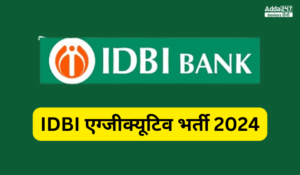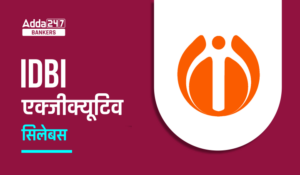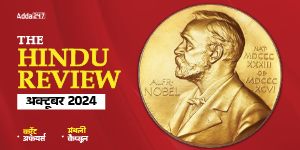
बैंकिंग परीक्षाओं के क्षेत्र में बढ़ती प्रतिस्पर्धा के साथ, अब सभी वर्गों को कुशलता से पूरा करना बहुत महत्वपूर्ण हो गया है। एक विषय जो आपको इन परीक्षाओं में न्यूनतम समय में अच्छे अंक प्राप्त करने में मदद कर सकता है वह है बैंकिंग जागरूकता। बैंकिंग जागरूकता प्रश्नावली न केवल आपको बैंकिंग परीक्षा के सामान्य जागरूकता अनुभाग, बल्कि बैंकिंग भर्ती के व्यक्तिगत इंटरव्यू राउंड में सफलता प्राप्त करने में आपकी सहायता करेगा, आज 10 जनवरी 2020 की बैंकिंग क्विज में परक्राम्य लिखत (Negotiable Instrument), विदेशी मुद्रा (Forex) भंडार , रिज़र्व बैंक ऑफ इंडिया आदि विषय संलग्न हैं:
Q1. भारत की कुल विदेशी मुद्रा (Forex) भंडार 06 दिसंबर 2019 तक लगभग 453 बिलियन अमेरिकी डॉलर है। भारत की विदेशी मुद्रा _________ के साथ रखा गया है।
(a) SBI
(b) ECGC
(c) RBI
(d) NABARD
(e) वित्त मंत्रालय
Q2. निम्नलिखित में से कौन-सा लेख-पत्र(Instrument) NI अधिनियम, 1881 के अनुसार परक्राम्य लिखत (Negotiable Instrument) नहीं है?
(a) विनिमय पत्र
(b) साख पत्र
(c) बैंक ड्राफ्ट
(d) प्रॉमिसरी नोट्स
(e) चेक
Q3. विदेशी मुद्रा अनिवासी (FCNR) योजना के तहत जमा न्यूनतम _______ के लिए स्वीकार किए जा सकते हैं
(a) 15 दिन
(b) 3 महीने
(c) 6 महीने
(d) 1 वर्ष
(e) 10 वर्ष
Q4. भारतीय रिज़र्व बैंक अस्थायी रूप से किसी एक राज्य सरकार को वित्तीय सहायता प्रदान करता है। इस प्रकार की वित्तीय सहायता को _______ कहा जाता है?
(a) ओवरड्राफ्ट
(b) अस्थायी ऋण
(c) अल्पावधि वित्त (Short term finance)
(d) तरीके और साधन अग्रिम (Ways and Means advance)
(e) दिए गए विकल्पों में से कोई भी सत्य नहीं है
Q5. ऋण प्राप्त करने के लिए निम्नलिखित में से कौन-सा रूप सबसे सुरक्षित है?
(a) ग्रहणाधिकार (Lien)
(b) असाइनमेंट
(c) गिरवी (Pledge)
(d) हाइपोथेकशन
(e) बंधक
Q6. जब बैंक एक निश्चित अवधि के लिए किसी व्यक्ति से निश्चित धनराशि स्वीकार करते हैं और ब्याज के साथ परिपक्वता (maturity) पर भुगतान करते हैं, तो जमा राशि को________ के रूप में जाना जाता है?
(a) मांग जमा
(b) सावधि जमा (term deposit)
(c) बौंड (bond)
(d) बंधक
(e) अग्रिम
Q7. निम्नलिखित में से किस सार्वजनिक क्षेत्र के बैंक ने 1965 में शताब्दी (centenary) वर्ष मनाया है?
(a) सेंट्रल बैंक ऑफ इंडिया
(b) इलाहाबाद बैंक
(c) भारतीय स्टेट बैंक
(d) बैंक ऑफ महाराष्ट्र
(e) बैंक ऑफ बड़ौदा
Q8. केंद्रीय सहकारी बैंक का प्राथमिक कार्य क्या है?
(a) राज्य सहकारी बैंकों से धन (funds) के प्रवाह को चैनलाइज करना
(b) अपने सदस्यों को अधिकतम संभव सीमा तक वित्तपोषण के लिए जिले में संसाधन जुटाना (mobilize the resources)
(c) बैंक के कोष में राज्य सहकारी बैंकों और संयुक्त स्टॉक से शेयर पूंजी, जमा, ऋण और ओवरड्राफ्ट शामिल हैं।
(d) उपरोक्त सभी
(d) दिए गए विकल्पों में से कोई भी सत्य नहीं है
Q9. वर्ष 2012 में, निम्नलिखित में से किस बैंक ने अपना 30 वां निरंतर सेवा (continuous service) वर्ष मनाया है?
(a) RBI
(b) SIDBI
(c) सेंट्रल बैंक ऑफ़ इंडिया
(d) NABARD
(e) SBI
Q10. निम्नलिखित में से कौन-सा संगठन/एजेंसी भारत में कृषि ऋण के प्रवाह की देखरेख और उसे व्यवस्थित करने के लिए काम करता/करती है?
(a) NABARD
(b) SIDBI
(c) RBI
(d) SEBI
(e) IRDAI
Q11. आरबीआई ने जून 2011 से निम्न में से किस मूल्यवर्गों (denominations) के सिक्के के संचलन को रोकने का निर्णय लिया है?
(a) 50 पैसे
(b) 1 रूपए
(c) 2 रूपए
(d) 25 पैसे
(e) 5 रूपए
Q12. भारत में बीमा कंपनियों द्वारा किसे विनियमित (regulate) किया जाता है-?
(a) RBI
(b) AMFI
(c) SEBI
(d) IRDAI
(e) NABARD
Q13. आर्थिक मामलों का विभाग, निम्नलिखित में से किस मंत्रालय का भाग है?
(a) गृह मंत्रालय
(b) योजना मंत्रालय
(c) वित्त मंत्रालय
(d) भारी उद्योग और सार्वजनिक उद्यम मंत्रालय
(e) ग्रामीण विकास मंत्रालय
Q14. निम्नलिखित में से किस मूल्यवर्ग के करेंसी नोट भारत में नहीं छपे हैं?
(a) 5 रूपए
(b) 10 रूपए
(c) 50 रूपए
(d) 1,000 रूपए
(e) 2,500 रूपए
Q15. संसद में प्रत्येक वर्ष पेश होने वाले केंद्रीय बजट को ________के नाम से भी जाना जाता है-
(a) गवर्नमेंट बजट
(b) कॉमन बजट
(c) जनरल बजट
(d) वर्ष की वित्त रिपोर्ट
(e) धन के आवंटन का विवरण
Solutions
S1. Ans.(c)
Sol. India’s total foreign exchange (Forex) reserves stand at around US$453 billion as on 06 December 2019. The Foreign exchange of India is kept with RBI.
S2. Ans.(b)
Sol. A letter of credit is a document that guarantees the buyer’s payment to the sellers.
S3. Ans.(d)
Sol. The Foreign Currency Non-Resident (FCNR) scheme was introduced with effect from May 15, 1993 to replace the then prevailing FCNR scheme introduced in 1975. The minimum maturity period of the deposit under the FCNR scheme, which was initially six months, was raised to one year, effective October, 1999. From July 26, 2005, banks were allowed to accept FCNR deposits up to a maximum maturity period of five years, against the earlier maximum limit of three years.
S4. Ans.(d)
Sol. The Reserve Bank of India gives temporary loan facilities to the centre and state governments as a banker to government. This temporary loan facility is called Ways and Means Advances (WMA).
S5. Ans.(c)
Sol. A pledged asset is a valuable possession that is transferred to a lender to secure a debt or loan. A pledged asset is collateral held by a lender in return for lending funds.
S6. Ans.(b)
Sol. A term deposit is a cash investment held at a financial institution. Your money is invested for an agreed rate of interest over a fixed amount of time, or term.
S7. Ans.(b)
Sol. On 24th 1865, Allahabad Bank was founded at the confluence city of Allahabad by a group of Europeans.
S8. Ans.(d)
Sol. All of the above options is primary function of a central co-operative bank.
S9. Ans.(d)
Sol. NABARD came into existence on 12 July 1982 by transferring the agricultural credit functions of RBI and refinance functions of the then Agricultural Refinance and Development Corporation (ARDC). It was dedicated to the service of the nation by the late Prime Minister Smt. Indira Gandhi on 05 November 1982. Set up with an initial capital of Rs.100 crore, its’ paid up capital stood at Rs.10,580 crore as on 31 March 2018. Consequent to the revision in the composition of share capital between Government of India and RBI, NABARD today is fully owned by Government of India.
S10. Ans.(a)
Sol. The importance of institutional credit in boosting rural economy has been clear to the Government of India right from its early stages of planning. Therefore, the Reserve Bank of India (RBI) at the insistence of the Government of India, constituted a Committee to Review the Arrangements For Institutional Credit for Agriculture and Rural Development (CRAFICARD) to look into these very critical aspects. The Committee was formed on 30 March 1979, under the Chairmanship of Shri B. Sivaraman, former member of Planning Commission, Government of India. The Committee’s interim report, submitted on 28 November 1979, outlined the need for a new organisational device for providing undivided attention, forceful direction and pointed focus to credit related issues linked with rural development. Its recommendation was formation of a unique development financial institution which would address these aspirations and formation of National Bank for Agriculture and Rural Development (NABARD) was approved by the Parliament through Act 61 of 1981.
S11. Ans.(d)
Sol. Coins up to 50 paise are called ‘small coins’ and coins of Rupee one and above are called ‘Rupee Coins’. Coins in the denomination of 1 paise, 2 paise, 3 paise, 5 paise, 10 paise, 20 paise and 25 paise have been withdrawn from circulation with effect from June 30, 2011 and are, therefore, no more legal tender.
S12. Ans.(d)
Sol. Insurance Regulatory and Development Authority (IRDA) set up as autonomous body under the IRDA Act, 1999. Insurance Regulatory and Development Authority of India is regulating and promoting the insurance and re-insurance industries in India.
S13. Ans.(c)
Sol. The Department of Economic Affairs, Ministry of Finance, is responsible for advice on economic issues having a bearing on internal and external aspects of the Indian economy including inflation, price control, foreign exchange management, Official Development Assistance domestic finance and preparation of the Union Budget, bilateral and multilateral engagement with international financial institutions and other countries.
S14. Ans.(e)
Sol. currency notes of RS 2, 500 denominations are not printed in India.
S15. Ans.(c)
Sol. Union Budget which is presented every year in the parliament is also known as general budget.



 IDBI Executive Recruitment 2024 Out: IDB...
IDBI Executive Recruitment 2024 Out: IDB...
 IDBI Executive Syllabus 2024: IDBI ए�...
IDBI Executive Syllabus 2024: IDBI ए�...
 SBI PO Previous Year Question Paper - SB...
SBI PO Previous Year Question Paper - SB...

